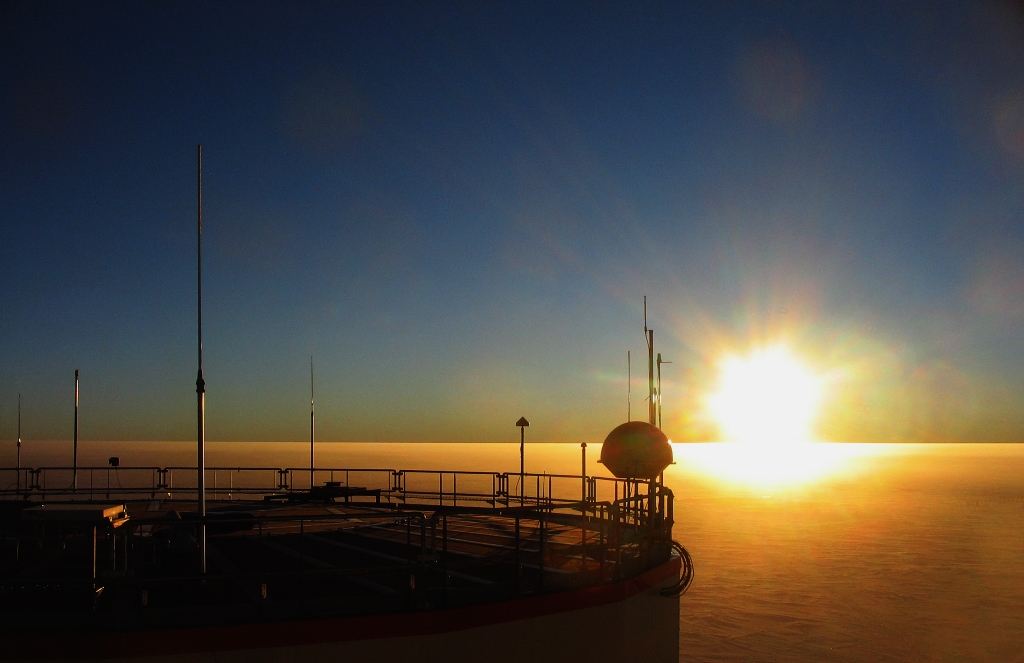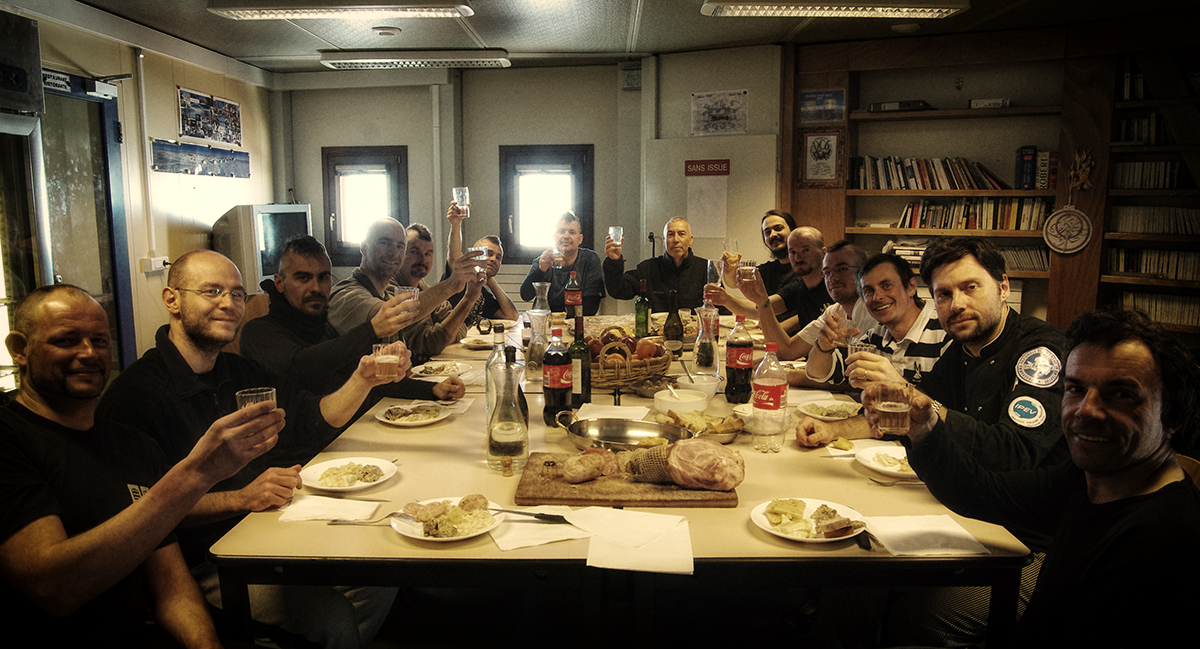Domenico Romano, astrophysicist and glaciologist, spent the winter at Concordia in 2011. Specially for this blog he wrote about the last aircraft leaving, signalling the start of the long winter.
The arrival of February marks the end of the summer campaign in Concordia. Most of the logistics personnel start leaving the base and human presence is reduced from 60 people to around 20 in just a few days. Among these 20 people are the crew that stay on for the whole winter. The workload intensifies in the run-up to the last plane departure.
Vehicles are stored safely in a cave called the Tubosider, as vehicles cannot be used in the winter due to the fuel freezing. The Tubosider is sealed using a large excavator that compacts ice at the cave’s entrance to prevent snow coming in during the winter storms to come. The excavator is the only vehicle to withstand the harsh temperatures of winter. Its operation is crucial, as the machine and its operator are required for Concordia’s drinking water. The excavator takes snow from specially reserved areas and puts them in a melting tank to melt the ice into water through a system of heaters.
As February progresses the shadows of the two towers become longer. The Sun, after three months of permanent presence, starts to touch the horizon. After many weeks of living under an intense blue the sky starts to be painted with a yellowish reflection reminiscent of sunsets at home. The Antarctic plateau indulges the viewer with whims of light and colour with shades ranging from blue to red. In a few days the Concordia crew will experience their first sunset.
Those who remain have conflicting emotions. On the one hand there is the desire to finally begin the winter adventure, as a spaceship crew might feel as it leaves the safe harbour of Earth-orbit. Once the last plane leaves, there is no chance to leave Concordia. We were well aware that everything depended on us and it was our responsibility to make sure that all went well.
On the other hand there is the sadness of saying goodbye to the people with whom we joked, discussed and worked with side-by-side for weeks. Inevitably bonds were formed. Some of the departing crew we would see again in nine months.
The departure arrived early in the morning. Farewells required a bit of time, final instructions were given to the wintering crew and some of us gave items to be delivered to loved ones.
Shortly after the door closed of the historic DC-3 Dakota aircraft (seeing it from the outside makes it looks more spacious than it actually is) the noise of the first propeller-engine became deafening. Standing in our suits with our hands held high in greeting, the second propeller started spinning and a cloud of dusty ice rose behind the aircraft. The sound of the engines became more acute, a sign that it has increased speed and a few minutes later the plane was on the runway waiting for a “go-fly” from the radio room.
The roar of the engines increased even more and the aircraft accelerates on its runway ice rink. More than a kilometre later it lifted off the ground, climbed and, following tradition, made a wide turn back above Dome C to greet us.
Before realising it, the plane moved away to the point of no longer being visible. In Concordia, the clock registered 10:47 on 5 February 2011. 17:47 Italian time, winterover starts now. We knew that, in case of emergency, we could be retrieved up to the end of February by a special flight from McMurdo station. We are not quite yet in total isolation.
Being the only ones left propelled us for the first time into what was to be our everyday life for the next nine months and we related differently to the base and its spaces in the new situation.
An hour later, tables and chairs were moved to the living room, where during the summer we enjoyed a little relaxation after a meal, chatting and having our weekly meetings. From then on the space was used for dining. A toast to the winterover crew.
Nel 2011 Domenico Romano, astrofisico e glaciologo, ha trascorso l’inverno a Concordia. Per questo blog ha scritto della partenza dell’ultimo aereo, che segna l’inizio di un lungo inverno.L’arrivo di febbraio sancisce la fine della campagna estiva a Concordia. Gran parte del personale logistico è gia partito dalla base ed ormai la presenza umana si è ridotta in pochi giorni da circa 60 persone a poco più di 20. Tra questi 20 c’è l’equipaggio invernale. Nei giorni immediatamente precedenti la partenza dell’ultimo aereo il lavoro in base si intensifica. Vengono posti in sicurezza, all’interno del tubo sider, i mezzi che non potranno essere usati durante l’inverno (a causa del congelamento del carburante) e si completano gli ultimi lavori. Il tubo sider viene sigillato usando un grosso escavatore che compatta il ghiaccio davanti il portale d’entrata per evitare le infiltrazioni di neve durante le bufere che si susseguiranno nei prossimi mesi. L’escavatore (chargeuse) è l’unico mezzo che sarà in grado di resistere alle temperature rigide dell’inverno. La sua operatività è cruciale poiché a questo ed al suo operatore è assegnato il compito di sopperire al fabbisogno idrico della base, prelevando la neve da appositi siti e scaricandola all’interno del fondoir (un container opportunamente modificato atto a sciogliere il ghiaccio tramite un sistema di riscaldatori).

Credits: IPEV/PNRA-D. Romano
Le ombre delle due torri si fanno via via più lunghe. Il sole, dopo tre mesi di presenza initerrotta, sta ormai sfiorando l’orizzonte. Dopo molte settimane di blu intenso si torna a rivedere il cielo dipinto di un riflesso giallastro che ricorda i tramonti di casa. Il plateau asseconda i capricci della luce e si colora anch’esso con sfumature che vanno dal blu al rosso. In pochi giorni si avrà il primo tramonto.
Sono contrastanti i sentimenti di chi rimane. Da una parte c’è la voglia di iniziare finalmente l’avventura del winterover. Come un equipaggio di una nave spaziale che lascia l’attracco sicuro in orbita attorno la Terra, così noi, una volta partito l’ultimo aereo, non avremo possibilità di andarcene dalla nostra base. Ogni cosa dipenderà da noi e sarà nostra responsabilità far si che tutto vada per il meglio. Dall’altra parte si salutano le persone con le quali si è scherzato, discusso e lavorato fianco a fianco per settimane e con le quali inevitabilmente si è stabilito un legame. Alcuni di loro li rivedremo fra nove mesi.
Il giorno della partenza è arrivato, di mattina presto. I saluti richiedono un po’ di tempo, vengono date le ultime istruzioni agli invernanti e qualcuno di noi lascia un qualcosa da far recapitare ai propri cari.
Si chiude il portellone dello storico dc-3 Dakota, a vederlo da fuori sembra più spazioso di quello che è in realtà, e poco dopo il rumore dei motori di una delle due eliche inizia a farsi sempre più assordante. Schierati nelle nostre tute agitiamo le mani in segno di saluto, anche la seconda elica inizia a girare e una nube di polvere di ghiaccio si alza dietro l’aereo. Il suono dei motori si fa più acuto, segno che ha aumentato i giri, pochi minuti dopo è sulla pista in attesa del “go volo” dalla sala radio. Questa volta il rombo dei motori è ancora più acuto e l’aereo accelera percorenndo sui suoi sci la pista ghiacciata. Un chilometro dopo si è staccato dal suolo, sale su e dopo un’ampia virata torna indietro effettuando, come vuole la tradizione, un passaggio sopra Dome C per salutare gli invernati rimasti. Prima di rendercene conto l’aereo si allontana al punto da non essere più visibile. A Concordia l’orologio segna le 10.47 del 5 febbraio 2011, le 17.47 in Italia, il winterover è iniziato ora. Sappiamo che, in caso di necessità, fino a fine febbraio, potremmo essere recuperati da un volo straordinario proveniente da McMurdo, non siamo ancora in isolamento totale.
L’essere rimasti solo noi invernanti ci proietta per la prima volta in quella che sarà la nostra quotidianità per i prossimi nove mesi e ci rapporta in modo diverso alla base ed ai suoi spazi.
Un’ora dopo alcuni tavoli della mensa vengono spostati in living room, il soggiorno nel quale durante l’estate si godeva di un po’ di relax dopo i pasti, si chiaccherava e si effettuava il meeting settimanale, da oggi sarà la nostra sala da pranzo. Ora che siamo rimasti in 14 brindiamo all’inizio del nostro winterover.








Discussion: one comment
So glad to read about this. I know what you feel and I understand. That last aircraft will serve as a good memory.